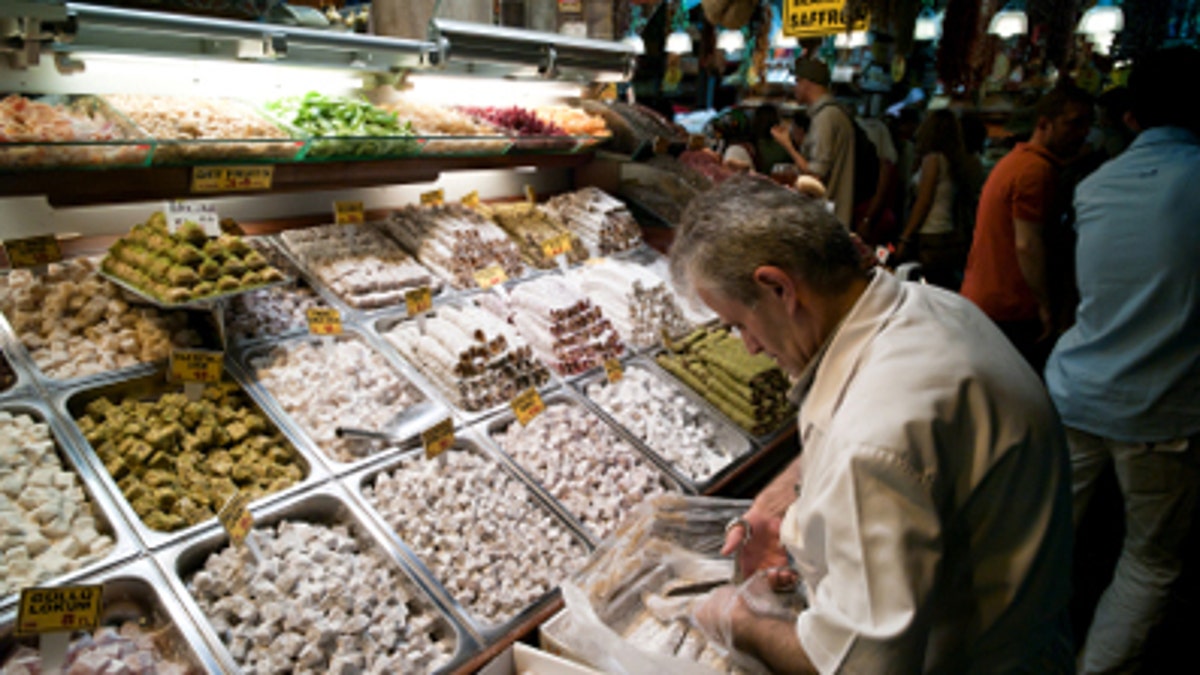
Turkish Delight for sale in Istanbul (iStock)
Culinary indulgences come easy to the traveler, especially when it comes to something sweet. Most destinations have at least one signature dessert – that one confection that they do so well; that certain dish that has history in every bite. Here are six cities and their famous desserts to try:
Turkish Delight in İstanbul
Ali Muhiddin Hacı Bekir was the most famous of all Ottoman confectioners. He came to İstanbul from the mountain town of Kastamonu in 1777 and opened a shop in the Old City where he concocted delicious boiled sweets and the translucent jellied jewels known to Turks as lokum - and to the rest of the world as Turkish Delight. Today, locals still buy their lokum from branches of the business he began over two centuries ago.
The flagship store of Ali Muhiddin Hacı Bekir is located near the Spice Bazaar. There are also stores on İstiklal Caddesi and in the produce market at Kadıköy. A more recent family dynasty has been established at Herşey Aşktan, opposite Pera Palace Hotel. Its delicious Turkish Delight can be packaged in decorative boxes, creating a perfect gift to take home to friends and family.
Cheesecake in New York
Sure, cheesecake, in one form or another, has been baked and eaten in Europe since the 1400s. But New Yorkers have appropriated its history in the form of the New York-style cheesecake. Immortalized by Lindy’s restaurant in Midtown, (which was opened by Leo Lindemann in 1921) the version served there – made of cream cheese, heavy cream, a dash of vanilla and a cookie crust – became wildly popular in the ’40s. Junior’s, which opened on Flatbush Ave in Brooklyn in 1929 (and more recently in Midtown) makes its own famous version of the creamy cake with a graham-cracker crust.
Gelato in Florence
During Renaissance and 16th-century Florence, two cooks made ice-cream history: Ruggeri, a chicken farmer who made it to the culinary big time thanks to a sorbet he made for Catherine Medici; and Bernardo Buontalenti, a well-known architect who produced a frozen dessert based on zabaglione (a dessert of whipped egg yolks, sugar and sweet wine) and fruit. Both are considered founding fathers of Italy‘s gelato culture. You’ll usually be asked if you want panna (cream) with your ice cream. A good call is si.
Florentines take their gelato seriously. There’s a healthy rivalry among the local gelaterie artigianale (makers of handmade gelato), who all strive to create the creamiest, most flavorful and freshest product in the city. Flavors change according to what fruit is in season. Three of our favorites are: Gelateria dei Neri (semifreddo-style; cheaper than its competitors; wild flavors like gorgonzola); Gelateria Vivoli (tubs only – eat in the pretty piazza nearby); and Grom (a newcomer using many organic ingredients).
----------
Also from Lonely Planet::
The world’s top chocolate spots
The world’s best gourmet sights
----------
Gula Melaka in Melaka
Made from sago, palm sugar and coconut milk, this traditional dessert is rarely served outside of the home. While gula melaka refers to palm sugar, it plays such an intrinsic part of this popular sweet that the dessert is commonly known by that name, although you may see it called Sago Gula Melaka. You may find it on the menu of a few Malaysian restaurants, particularly in Melaka, but why not try mastering it yourself by following this recipe?
Brussels Waffles in Ghent
A sure-fire way to tell natives from tourists is how they order waffles. Locals never order them consume these sweet snacks with whipped cream, chocolate or other elaborate toppings (except sometimes fruit). Instead, a Brussels waffle – a large, light rectangle with 20 ‘squares’, usually eaten in tearooms and brasseries – is traditionally buttered and sprinkled only with icing sugar.
Etablissement Max is an elegant brasserie run by Yves Van Maldeghem whose entrepreneurial family started out with a mobile waffle stall at a fair. Yves bakes waffles using his family’s 120-year old waffle irons, and also makes pancakes and sizzling apple fritters. To bake your own, pick up Jan Gheysens’ Belgian Waffles and Other Treats here, which contains Yves’ family recipes.
Pastel de Nata in Lisbon
With every bite of a Portuguese sweet, you’re consuming a little bit of history. Portugal‘s sweets industry was crystallized when the Arabs introduced sugar to the country. In medieval times, enterprising nuns and monks made – and sold – doces conventuais (literally, convent sweets). The best known of these is the pastel de nata, a creamy, egg-based custard tart. Why the eggs? The story goes that nuns stiffened their habits with egg whites and, to consume the leftover yolks, devised special recipes. Since 1837, a patisserie called Antiga Confeitaria de Belém has been transporting locals to sugarcoated nirvana with heavenly pastéis de belém: crisp pastry nests filled with custard cream, baked at 200°C for that perfect golden crust, then lightly dusted with cinnamon.
Originally published as “How sweet it is: destinations and their desserts” © 2011 Lonely Planet. All rights reserved.
